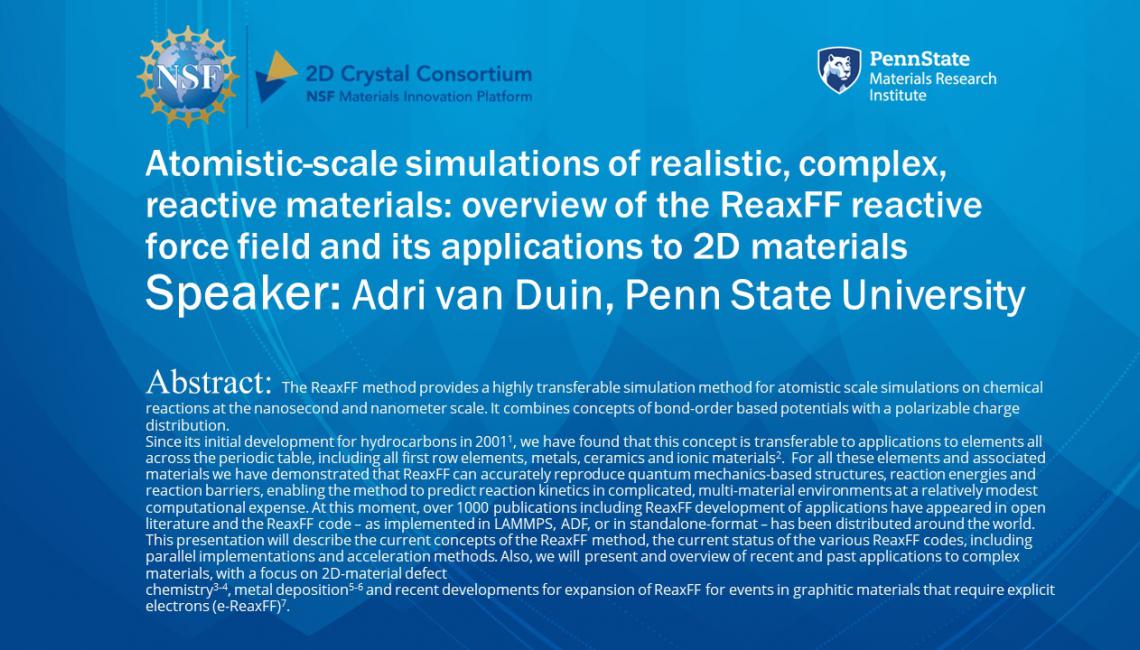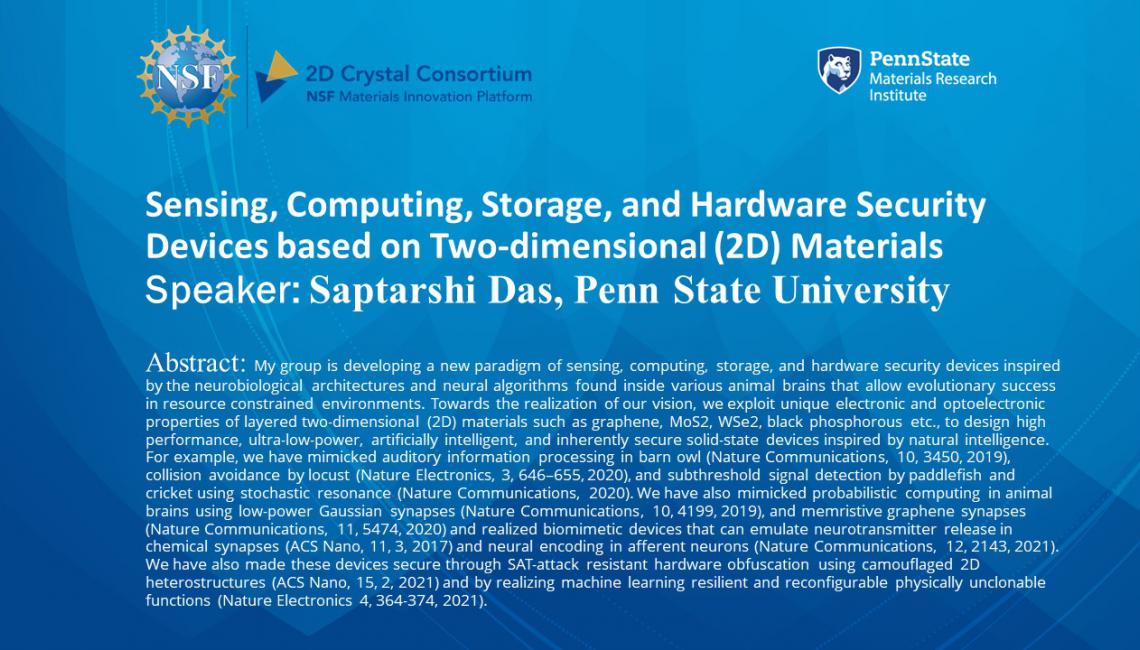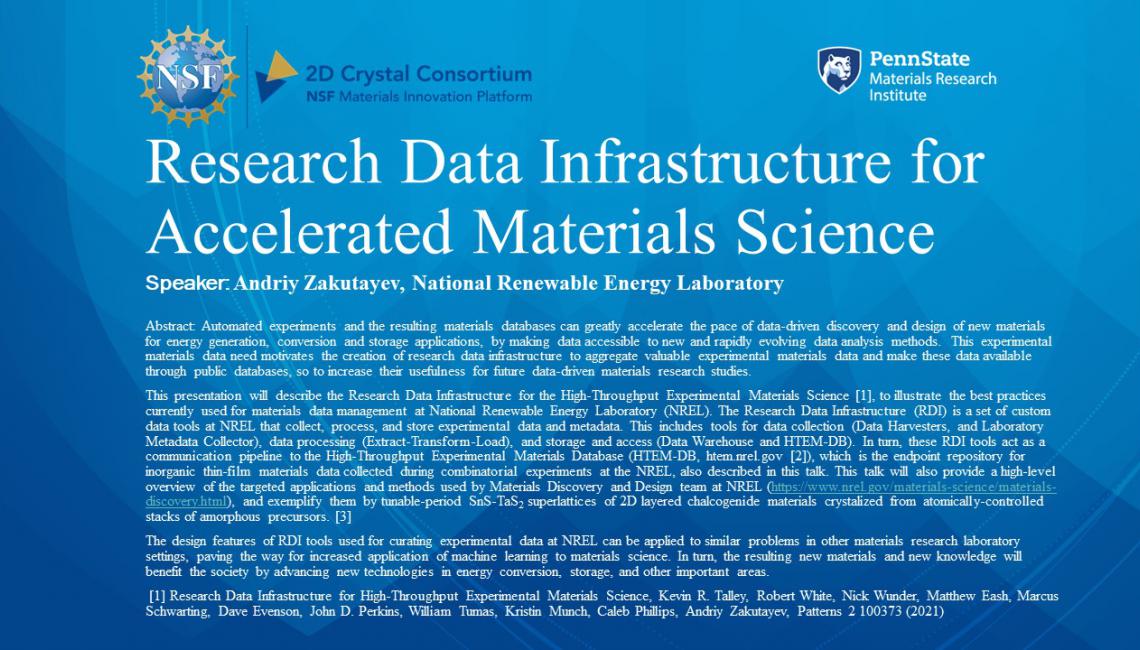2D moiré Quantum Materials
Watch recording above or on YouTube
Date: Thursday, November 17, 2022
Speaker: Jie Shan, Cornell University
Abstract: When two van der Waals materials of slightly different orientations or lattice constants are overlaid, a moiré pattern emerges. The moiré pattern introduces a new length scale (many times the lattice constant of the original materials) and periodic potentials. This strongly suppresses the kinetic energy of the electrons and gives rise to rich strongly correlated electron phenomena. In this talk, I will review recent progress on the development of 2D semiconductor moiré materials and realization of different many-body Hamiltonians. I will also discuss the opportunities and challenges in designing moiré materials and developing quantum simulators based on these artificial 2D materials.
Mechanical Perturbation of Topological Materials
Watch recording above or on YouTube
Date: Thursday, October 27, 2022
Speaker: Vikram Deshpande, University of Utah
Abstract: Topological materials have burgeoned of late due to their implications for the fields of electronics, spintronics and quantum computing, among others. While their electronic properties are important in their own right, they can also couple in fascinating ways to the lattice. We have developed techniques to deform materials controllably and study their resulting electronic properties in-situ, while complementarily sensing the electronic ground state through the mechanical degree of freedom. In this talk, by way of introduction, I will first present purely electrical measurements on the prototypical topological material, the three-dimensional (3D) topological insulator (TI), wherein we hybridize Dirac cones of 3D TI surfaces controllably to realize the quantum spin Hall effect in the ultrathin limit. Then I will present our recent results applying the above-mentioned mechanical techniques to two different topological materials, namely twisted bilayer graphene (TBG) and the intrinsic magnetic topological insulator (MTI) MnBi2Te4, respectively. We are able to tune the Hofstadter’s spectrum of non-magic angle TBG and induce magnetism in non-magnetic correlated insulating states of magic-angle TBG using isotropic strain, for example, and detect magnetic states and measure magnetoelastic couplings in the case of MTIs. Our advances present unique routes to tuning and sensing the parameter space of these exciting materials.
Epitaxy of 2D mono-, di-and trichalcogenideswith a focus on rotational domains
Watch recording above or on YouTube
Date: Thursday, September 29, 2022
Speaker: Wouter Mortelmans, MIT
Abstract: Two-dimensional chalcogenides are a promising class of van der Waals materials encompassing novel properties and functionalities for new micro- and optoelectronic applications. The integration of 2D chalcogenides relying on industry-compatible manufacturing processes is still a challenge which is restricting these materials to the lab environment only. The large-area and single-crystalline epitaxial growth of 2D chalcogenides is a desirable approach to meet the demanding requirements on crystalline quality implied by the semiconductor industry. This talk will contribute to a better understanding on the epitaxial growth of 2D chalcogenides with a focus on the formation of rotational domains and its impact on extended defects like grain boundaries.
Atomistic-scale simulations of realistic, complex, reactive materials: overview of the ReaxFF reactive force field and its applications to 2D materials
Watch recording above or on YouTube
Date: Thursday, April 28, 2022
Speaker: Adri van Duin, Penn State University
Abstract: The ReaxFF method provides a highly transferable simulation method for atomistic scale simulations on chemical reactions at the nanosecond and nanometer scale. It combines concepts of bond-order based potentials with a polarizable charge distribution.
Since its initial development for hydrocarbons in 20011, we have found that this concept is transferable to applications to elements all across the periodic table, including all first row elements, metals, ceramics and ionic materials2. For all these elements and associated materials we have demonstrated that ReaxFF can accurately reproduce quantum mechanics-based structures, reaction energies and reaction barriers, enabling the method to predict reaction kinetics in complicated, multi-material environments at a relatively modest computational expense. At this moment, over 1000 publications including ReaxFF development of applications have appeared in open literature and the ReaxFF code – as implemented in LAMMPS, ADF, or in standalone-format – has been distributed around the world.
This presentation will describe the current concepts of the ReaxFF method, the current status of the various ReaxFF codes, including parallel implementations and acceleration methods. Also, we will present and overview of recent and past applications to complex materials, with a focus on 2D-material defect
chemistry3-4, metal deposition5-6 and recent developments for expansion of ReaxFF for events in graphitic materials that require explicit electrons (e-ReaxFF)7.
References
[1] van Duin, A. C. T., Dasgupta, S., Lorant, F., and Goddard, W. A., 2001. ReaxFF: A reactive force field for hydrocarbons. Journal of Physical Chemistry A 105, 9396-9409.
[2] Senftle, T., Hong, S., Islam, M., Kylasa, S.B., Zheng, Y., Shin, Y.K., Junkermeier, C., Engel-Herbert, R., Janik, M., Aktulga, H.M., Verstraelen, T., Grama, A.Y. and van Duin, A.C.T. (2016) The ReaxFF Reactive Force-field: Development, Applications, and Future Directions. Nature Computational Materials 2, 15011.
[3] Hickey, D.R., Nayir, N., Chubarov, M., Choudhury, T.H., Bachu, S., Miao, L., Wang, Y., Qian, C., Crespi, V.H., Redwing, J.M., van Duin, A.C.T. and Alem, N. (2021) Illuminating invisible grain boundaries in coalesced single-orientation WS2 monolayer films. Nano Letters 21, 6487-6495.
[4] Yilmaz, D., Boebinfer, M., Unocic, R.R. and van Duin, A.C.T. (2022) Understanding Defect Evolution in Chalcogenide Thin Films Under Transmission Electron Microscope Journal of Computational and Theoretical Chemistry in preparation.
[5] Nayir, N., Sengul, M.Y., Costine, A.L., Reinke, P., Rajabpour, S., Bansal, A., Kozhakhmetov, A., Robinson, J., Redwing, J. and van Duin, A.C.T. (2022) Atomic-scale Probing of Defect-assisted Ga intercalation through Graphene using ReaxFF Molecular Dynamics Simulations. Carbon 190, 276-290.
[6] Rajabpour, S., Mao, Q., Nayir, N., Robinson, J. and van Duin, A.C.T. (2021) Development and Applications of ReaxFF Reactive Force Fields for Group-III Gas-Phase Precursors and Surface Reactions with Graphene in MOCVD Synthesis Journal of Physical Chemistry 125, 10747-10758.
[7] Leven, I., Hao, H., Tan, S., Penrod, K.A., Akbarian, D., Hossain, M.J., Evangelisti, B., Islam, M., Koski, J., Moore, S., Aktulga, H.M., van Duin, A.C.T. and Head-Gordon, T. (2021) Recent Advances for Improving the Accuracy, Transferability and E_fficiency of Reactive Force Fields. Journal of Chemical Theory and Computation 17, 3237-3251.
Sensing, Computing, Storage, and Hardware Security Devices based on Two-dimensional (2D) Materials
Watch recording above or on YouTube
Date: Thursday, March 31, 2022
Speaker: Saptarshi Das
Abstract: My group is developing a new paradigm of sensing, computing, storage, and hardware security devices inspired by the neurobiological architectures and neural algorithms found inside various animal brains that allow evolutionary success in resource constrained environments. Towards the realization of our vision, we exploit unique electronic and optoelectronic properties of layered two-dimensional (2D) materials such as graphene, MoS2, WSe2, black phosphorous etc., to design high performance, ultra-low-power, artificially intelligent, and inherently secure solid-state devices inspired by natural intelligence. For example, we have mimicked auditory information processing in barn owl (Nature Communications, 10, 3450, 2019), collision avoidance by locust (Nature Electronics, 3, 646–655, 2020), and subthreshold signal detection by paddlefish and cricket using stochastic resonance (Nature Communications, 2020). We have also mimicked probabilistic computing in animal brains using low-power Gaussian synapses (Nature Communications, 10, 4199, 2019), and memristive graphene synapses (Nature Communications, 11, 5474, 2020) and realized biomimetic devices that can emulate neurotransmitter release in chemical synapses (ACS Nano, 11, 3, 2017) and neural encoding in afferent neurons (Nature Communications, 12, 2143, 2021). We have also made these devices secure through SAT-attack resistant hardware obfuscation using camouflaged 2D heterostructures (ACS Nano, 15, 2, 2021) and by realizing machine learning resilient and reconfigurable physically unclonable functions (Nature Electronics 4, 364-374, 2021).
Research Data Infrastructure for Accelerated Materials Science
Watch recording above or on YouTube
Date: Thursday, February 24, 2022
Speaker: Andriy Zakutayev, National Renewable Energy Laboratory
Abstract: Automated experiments and the resulting materials databases can greatly accelerate the pace of data-driven discovery and design of new materials for energy generation, conversion and storage applications, by making data accessible to new and rapidly evolving data analysis methods. This experimental materials data need motivates the creation of research data infrastructure to aggregate valuable experimental materials data and make these data available through public databases, so to increase their usefulness for future data-driven materials research studies.
This presentation will describe the Research Data Infrastructure for the High-Throughput Experimental Materials Science [1], to illustrate the best practices currently used for materials data management at National Renewable Energy Laboratory (NREL). The Research Data Infrastructure (RDI) is a set of custom data tools at NREL that collect, process, and store experimental data and metadata. This includes tools for data collection (Data Harvesters, and Laboratory Metadata Collector), data processing (Extract-Transform-Load), and storage and access (Data Warehouse and HTEM-DB). In turn, these RDI tools act as a communication pipeline to the High-Throughput Experimental Materials Database (HTEM-DB, htem.nrel.gov [2]), which is the endpoint repository for inorganic thin-film materials data collected during combinatorial experiments at the NREL, also described in this talk. This talk will also provide a high-level overview of the targeted applications and methods used by Materials Discovery and Design team at NREL (https://www.nrel.gov/materials-science/materials-discovery.html), and exemplify them by tunable-period SnS-TaS2 superlattices of 2D layered chalcogenide materials crystalized from atomically-controlled stacks of amorphous precursors. [3]
The design features of RDI tools used for curating experimental data at NREL can be applied to similar problems in other materials research laboratory settings, paving the way for increased application of machine learning to materials science. In turn, the resulting new materials and new knowledge will benefit the society by advancing new technologies in energy conversion, storage, and other important areas.
[1] Research Data Infrastructure for High-Throughput Experimental Materials Science, Kevin R. Talley, Robert White, Nick Wunder, Matthew Eash, Marcus Schwarting, Dave Evenson, John D. Perkins, William Tumas, Kristin Munch, Caleb Phillips, Andriy Zakutayev, Patterns 2 100373 (2021)
[2] An open experimental database for exploring inorganic materials. Zakutayev, A., Wunder, N., Schwarting, M., Perkins, J.D., White, R., Munch, K., Tumas, W., Phillips, C. Scientific data, 5 180053 (2018)
An Overview of 2D Research in the Advanced Materials Group
Watch recording above or on YouTube
Date: Thursday, January 27, 2022
Speaker: Tomas Polcar, University of Southampton, UK & Czech Technical University in Prague, Czech Republic
Abstract: 2D materials, such as graphene or transition metal dichalcogenides, are promising solid lubricants. We establish links between fundamental frictional properties of selected 2D materials by ab initio methods, molecular dynamics and nanoscale friction experiments. When combined as heterostructures with a large lattice mismatch (e.g., MoS2 on graphene), these materials can reach superlubricity with a coefficient of friction as low as 10-6. However, their applicability as externally supplied lubricants in mainstream engineering applications is limited. We will show that low-dimensional transition metal dichalcogenides minimizing friction could be produced continuously during the sliding process from various amorphous nanostructured mixtures.
Title: A New Reactive Force Field for Molybdenum Disulfide
Speaker: Ilia Ponomarev, Czech Technical University in Prague
Abstract: Molybdenum disulfide is a layered material with a broad range of applications, such as tribological coatings, materials for electronics and catalysis. Accurate large-scale simulations of the Mo-S systems can be very beneficial for guiding the experimental development of MoS2-based materials and figuring out underlying mechanisms of their functioning. In this work we present a tool for such simulations, our newly developed ReaxFF parameterization for the Mo-S system



